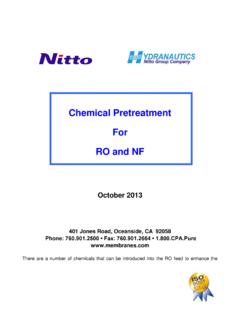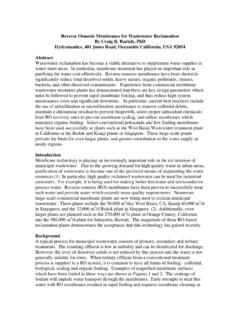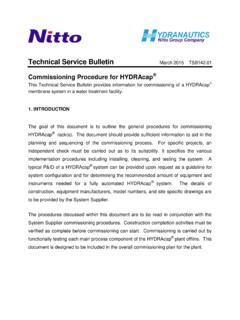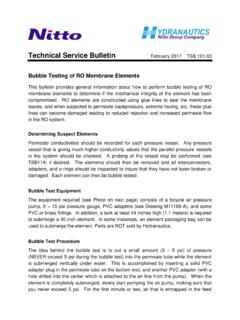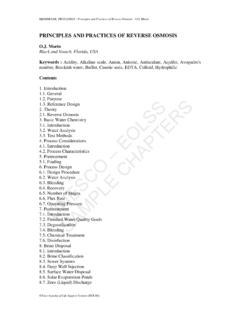Transcription of RO Water Chemistry - Hydranautics
1 Hydranautics RO Water Chemistry Alkalinity: Alkalinity is comprised primarily of bicarbonate, carbonate and hydroxide ions. Naturally occurring alkalinity functions as the earth s natural buffering system. An example of this buffering capability occurs when small doses of strong acids ( acid rain) react with the alkalinity in Water . The acid converts carbonates to bicarbonates and converts bicarbonates to carbon dioxide, with both reactions resulting in very little change in the pH of the Water . It should be noted that dissolved carbon dioxide gas will react with Water to form a very weak carbonic acid, but this is not considered to be part of total alkalinity since it has no acid buffering capacity. Carbon dioxide and bicarbonate are in a balance between the pH range of to at the low end and at the high end. At a pH of to or lower, all alkalinity is in the form of carbon dioxide.
2 At a pH of to , there is no carbon dioxide and all alkalinity is bicarbonate. Bicarbonate and carbonate are in a balance between the pH range of to at the low end and at the high end. At a pH of , there is no carbon dioxide or bicarbonate, and all alkalinity is carbonate. As the pH increases above , hydroxyl alkalinity (due to the presence of the hydroxide ion) starts to occur. Most naturally occurring Water sources have a pH between 6 and , so the presence of hydroxides is the result of man-made activity. Alkalinity, especially by boiler Water chemists, can be reported as M-Alkalinity and P-Alkalinity. M-Alkalinity (also known as Total Alkalinity) measures the amount of carbonate, bicarbonate and hydroxide present in terms of ppm as calcium carbonate . The M-Alkalinity measurement is based on a sulfuric acid titration using a Methyl orange indicator that goes from yellow at a pH of to orange at pH of at the endpoint.
3 P-Alkalinity measures the amount of carbonate and hydroxyl alkalinity present in terms of ppm as calcium carbonate . The P-Alkalinity measurement is based on a sulfuric acid titration using a Phenolphthalein indicator that goes from pink at a pH of to colorless at pH of at the endpoint. Author s Note: A range of pH values have been reported in a number of published sources for the M-alkalinity ( to ) and P-alkalinity ( to ) titration endpoints. The above values are the best estimate. Aluminum (Al): Aluminum, based on its low solubility, is typically not found in any significant concentrations in well or surface waters. Aluminum, when present in an RO feed Water , is typically colloidal in nature (not ionic) and is the result of alum carryover by an on-site or municipal clarifier or lime-softener. Alum (aluminum sulfate) is a popular coagulant that is effective in the absorption and precipitation of naturally occurring, negatively charged colloidal material ( clay and silt) from surface waters.
4 Alum, when introduced into Water , disassociates into trivalent aluminum and sulfate. The hydrated aluminum ion reacts with the Water to form a number of complex hydrated aluminum hydroxides, which then polymerize and starts absorbing the negatively charged colloids in Water . Fouling by aluminum-based colloid carryover can occur, with alert levels for the RO designer ranging from to ppm aluminum in the feed Water . Aluminum Chemistry is complicated by the fact that it is amphoteric. Aluminum at low pH s can exist as a positively charged trivalent cation or as an aluminum hydroxide compound. Aluminum at high pH s can exist as a negatively charged anionic compound. Typically, the range of least solubility for aluminum compounds is in the pH range of to Ammonium (NH4): A monovalent cation. Ammonium salts are very soluble and do not cause a RO scaling problem.
5 The ammonium ion is the result of very soluble gaseous ammonia (NH3) being dissolved in Water . Non-ionized ammonia ionizes in Water to form the ammonium ion and hydroxide ion. The degree of ionization of ammonia to ammonium is dependent on pH, temperature, and the ionic strength of the solution. At higher pH the ammonia gas is prevalent, and being a gas, will not be rejected by a RO (similar to carbon dioxide gas). At lower pH the ammonium ion is prevalent and is rejected by a RO. Ammonia and ammonium exists in an equilibrium at varying relative concentrations in the general pH range of to Ammonium is typically not found in well Water sources, having been converted by bacterial action in soils to the transitory nitrite (NO2) ion and then oxidized into the more prevalent nitrate ion. Ammonium is found in surface Water sources at low levels (up to 1 ppm as the ion), the result of biological activity and the breakdown of organic nitrogen compounds.
6 Surface sources can be contaminated with ammonium from septic systems, animal feed lot runoff, or agricultural runoff from fields fertilized with ammonia or urea. Ammonium is prevalent in municipal waste facilities with levels up to 20 ppm as the ion in the effluent, the result of high levels of organic nitrogen compound compounds and biological activity. Another source of ammonium is the result of adding ammonia to chlorine to form biocidal chloramines. Barium (Ba): A divalent cation. The solubility of barium sulfate (BaSO4) is low and can cause a RO scaling problem in the back-end of a RO. Barium sulfate solubility is lower with increasing sulfate levels and decreasing temperatures. Typically, barium can be found in some well waters, with typical concentrations less than ppm to ppm. It is important that barium be measured with instruments capable of ppm (10 ppb) minimum detection levels.
7 With saturation at 100%, super-saturation up to 6000% is typical with an antiscalant. Bicarbonate (HCO3): A monovalent anion. The solubility of calcium bicarbonate is low and can cause a RO scaling problem in the back-end of a RO. Calcium bicarbonate solubility is measured using LSI (Langlier Saturation Index) for brackish waters or the Stiff-Davis Index for seawaters and is lower with increasing temperature and increasing pH. Bicarbonate is one component of alkalinity and its concentration is in a balance with carbon dioxide between the pH range of and and in a balance with carbonate between the pH range of and BOD (Biological Oxygen Demand): BOD is a non-specific test that measures the quantity of biologically-degradable organic matter and is reported as ppm as oxygen . The test measures the quantity of oxygen depletion resulting from the ability of common bacteria to digest organic matter during a 5-day incubation period at 20o C.
8 Boron (B): Boron can be found in seawater at levels up to 5 ppm and at lower levels in brackish waters where inland seas once existed. Boron is not a foulant. The removal of boron to ppb levels is an important issue in the electronics industry as it adversely affects the process in some applications. The removal of boron is important in the production of potable/irrigation Water in seawater desalination , with suggested limits of ppm boron. The element boron exists in equilibrium as the borate monovalent anion B(OH)4- at higher pH and as non-ionized boric acid B(OH)3 at lower pH. The relative concentrations of borate and boric acid are dependent on pH, temperature and salinity. The borate ion becomes more prevalent at higher pH, higher salinity and higher temperature. The rejection of boron by RO is better for the borate ion due to its charge.
9 The rejection of non-ionized boric acid is low due to its smaller size and lack of electric charge. Brackish Water : Brackish Water , in one sense, is defined as a fresh low TDS Water source that experiences a large increase in normal TDS due to seawater intrusion. In the RO field, brackish Water can be defined as feed Water with low to medium TDS levels (up to 10,000 to 15,000 ppm) that can be treated with a brackish RO element designed for 600 psi maximum applied feed pressure. Calcium (Ca): A divalent cation. Calcium, along with magnesium, is a major component of hardness in brackish Water . The solubility of calcium sulfate (CaSO4)(gypsum) is typically limited to 230% with the use of an antiscalant. The solubility of calcium carbonate is typically limited to a LSI (Langlier Saturation Index) value of positive to Carbon Dioxide (CO2): Carbon dioxide is a gas that when dissolved in Water reacts with the Water to form weak carbonic acid (H2CO3).
10 If a pure Water was completely saturated with carbon dioxide, its concentration would be about 1600 ppm and the pH would be about A typical source for carbon dioxide in natural waters is the result of a balance with bicarbonate alkalinity based on the pH of the Water . The concentration of carbon dioxide in Water is typically indirectly determined by graphical comparison to the bicarbonate concentration and pH. Carbon dioxide and the bicarbonate ion are in a balance between the pH range of and The alkalinity is all carbon dioxide at pH and is all bicarbonate at pH The RO design program calculates the carbon dioxide level based on the bicarbonate level and pH of the Water . Carbon dioxide, being a gas, is not rejected or concentrated by a RO membrane, therefore its concentration will the same in the feed, permeate and concentrate.

